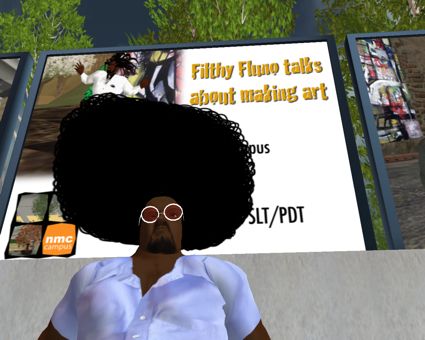Early Adopters: The Art world of Second Life
 Second Life has been receiving a lot of press recently as an alternative Virtual Reality Art Market. The New York Times recently released an interview with Painter and Second Life Art Star, Filthy Fluno that chronicled the artist's use of Second Life and how it helps him to sell his paintings in the real world.
Second Life has been receiving a lot of press recently as an alternative Virtual Reality Art Market. The New York Times recently released an interview with Painter and Second Life Art Star, Filthy Fluno that chronicled the artist's use of Second Life and how it helps him to sell his paintings in the real world.
By mirroring his real world gallery space in Second Life, Filthy Fluno, the avatar of artist Jeffrey Lipsky, is able to expand his viewing audience worldwide beyond the four walls of his real world gallery space. Jeffrey creates his artwork in real life using oil paint and pastels on canvas, and is able to digitally insert his paintings into Second Life for exhibition. He is capitalizing on the community within Second Life to market himself to potential customers and make connections within this virtual world with event promoters and party planners.
In a recent e-mail conversation, Mr Lipsky said,
"Second Life is allowing tech savvy artists to circumnavigate many of the RL challenges in getting their artworks in front of the right people and institutions...customers, galleries, peers, and international audiences. SL is also being used as a platform to create new forms of interactive cyberarts and live performance experiences. My Real Life artwork is inspired by online virtual world cultures, people, and events. This is quite important aspect of why my artwork is able to blur the boundaries of "cyberart" and "traditional" art. "
The Second Life Art World is steadily increasing, with upwards of 600 confirmed art galleries as of March 2009, according to the Second life Art World Market Report. The PDF file available at the bottom of the Market Report page is an excellent source of information about the current state of the art world within Second Life.
The academic world has also begun to explore Second Life. Nettrice Gaskins, an artist and educator at the Massachusetts College of Art and Design and on the board of the National Alliance for Media Arts and Culture points out a recent exhibition within Second Life at the 322 Mixed Reality Gallery where arts education students at Penn State University created a virtual exhibition as part of a visual culture and educational technology course. She also brought up an interesting project entitled No Matter, where she is collaborating with Boston Arts Academy to create a interdisciplinary project for their engineering program. 25 builders and artists are commissioned to create art objects in second life based upon "Imaginary Objects" such as The Time Machine or Schrödinger’s Cat, which are then re-created as 3-d paper models. The objects exist both in the real world, as these paper models, and the virtual world within Second Life.
Along with visual arts, the performing arts have found a steady foothold within Second Life. Music Island is quickly becoming a significant Second Life destination for classical and contemporary music performances. Created by Linda Rogers and receiving around 2,000 visitors every month, Music Island provides a virtual performance venue for Second Life artists where avatars of the actual musicians perform on stage.
This is by no means the only music destination within Second Life. The Royal Liverpool Philharmonic Orchestra built the art deco Liverpool Philharmonic Hall in Second Life and hosted its first concert there in September 2007. Unlike Music Island, they are using recorded digital video instead of musician avatars for their performances.
In a recent conversation, Linda Rogers expressed that it is useful to think of the immersive environment of Second Life not as just a corner of the internet, but the next step in the evolution of electronic communication. She stated that the real time, live and synchronous nature of a 3-D virtual environment allows for more audience interaction and creates a sense of occasion at gallery openings, concerts, and exhibits that just does not exist within the flat online world. Avenues are being created to do everything from allowing artists to create virtual movie sets for machinama, to bringing together an international community of both artists and audiences that help to broaden artistic perspective and foster collaboration.
With the increase in the use of Second Life, I think that we may begin to see more and more alternative online three dimensional social environments crop up that are condusive to the production and exhibition of art, especially as processor speeds continue to increase and the prices for high end graphics cards start to fall.